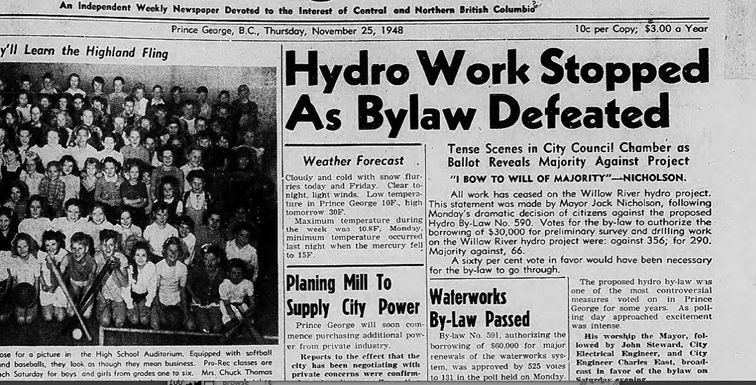This week in Prince George history, Nov. 20-26:
Nov. 25, 1948: The City of Prince George stopped work on a proposed hydroelectric dam on the Willow River, after a bylaw to borrow $30,000 for preliminary surveying and drilling was defeated in a public vote on Nov. 22, 1948.
Voters rejected the borrowing bylaw 356 to 290, leaving Mayor Jack Nicholson and city council to look for alternative measures to meet the city's electricity demand.
"The proposed hydro bylaw was one of the most controversial measures voted on in Prince George in some years," The Citizen reported. "His worship the mayor, followed by John Steward, city electrical engineer, and city engineer Charles East, broadcast in favour of the bylaw on Saturday (Nov. 20) evening. During the morning (of the vote), pamphlets agasin the bylaw, issued by a body of ratepayers, appeared in the streets of the city."
Nicholson argued that the hydroelectric project would best meet the city's power needs of the day, and into the future. In addition, Nicholson argued that voters had already approved the dam through a plebiscite in 1947.
Opponents said the $1.3 million project wouldn't provide cheap power, and the $30,000 loan "was a waste of money," the Citizen reported.
"I am disappointed that the project did not go through," Nicholson told The Citizen. "I have stopped all work on the project. If the people change their minds it will be brought up again. This is a democratic country and we must bow to the will of the majority."
The same edition of The Citizen reported on the signing of a deal between the City of Prince George and Prince George Planing Mills Ltd. to purchase up to 900,000 kW per year for two years, at a cost of four cents were kilowatt for the first 500,000, five cents for the next 400,000 and three cents per kilowatt beyond that.
"The contract had first been contemplated by city officials as a stop-gap measure until the hydro plant was in operation," The Citizen reported. "However, as the Monday (Nov. 20) polling eliminated the possibility of hydro for some time, the council decided to approve the scheme as an additional power source for the electricity-hungry city."
The cost of the power purchased from the mill compared favourably to the city's own power plants.
Nicholson was right that in a democracy one must bow to the will of the people -even when the people are idiots.
Nov. 22 and Nov. 26, 1918: In a pair of articles published on Nov. 22 and Nov. 26, The Citizen outlined Canada's contribution to the First World War (then known as The Great War), which had ended only weeks ago on Nov. 11, 1918.
"When Canada entered the war on Aug. 14, 1914, she had a permanent force of only 3,000 men and an active militia of 60,000," The Citizen reported, based on statistics issued by the Militia Department. "When hostilities ceases on November 11, 1918, Canada had sent overseas 418,980. At first Canada supplied a division. This was increased until by 1916, she had in France an army corps of four divisions, a cavalry brigade and numerous other services, such as line of communication troops, railway troops and forestry corps.
"On September 30, 1918, Canadian troops in France numbered 156, 250. The Canadians engaged in the United Kingdom and France in constructing and operating railway lines and in cutting down forests and milling timber number about 50,000."
In addition, between 14,000 and 15,000 Royal Air Force personnel were recruited and trained in Canada, and many others joined while serving overseas.
Of those Canadians who served, 213,268 were reported as casualties as of Nov. 13, 1918. However that number "will likely be increased owing to the fact that the troops of the Dominion were engaged in heavy fighting at Mons up to the last minute of fighting, and reports of the latest casualties are still being received."
Of those casualties, 50,585 were killed - 35,128 were killed in action, 12,048 died of wounds received in the line of duty and 3,409 died of disease.
A further 4,620 were missing and presumed dead, 2,860 were prisoners of war and 842 were missing.
The remaining 154,361 casualties were wounded, some of which who would live with life-altering disabilities for the rest of their lives.
When the final tallies were done, 66,655 Canadians had died in the First World War and 172,950 were injured according to Veterans Affairs Canada's official statistics (which include injured soldiers who later died of their injuries, soldiers who died during the 1918-19 Spanish Flu Epidemic, or from other causes) - making it the deadliest conflict in Canadian history.
Canada's population in 1918 was less than 8.15 million, meaning that more than five per cent of the country's population served overseas during the war. In addition, approximately 200,000 served on the home front.
It's hard to image a conflict on that scale. Hopefully, those alive today will never experience a war of that magnitude.
To explore 100 years of local history yourself, visit the Prince George Citizen archives online at: pgc.cc/PGCarchive. The Prince George Citizen online archives are maintained by the Prince George Public Library.



